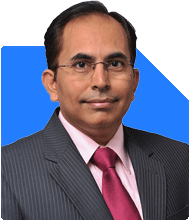46-Year-Old in India with ₹10 Crore Assets - Can I Retire at 50?
Janak Patel |71 Answers |Ask -Follow
MF, PF Expert - Answered on Mar 13, 2025
He is the CEO and founder of InfiniumWealth, a firm that specialises in designing goal-specific financial plans tailored to help clients achieve their life goals.
Janak holds an MBA degree in finance from the Welingkar Institute of Management Development and Research, Mumbai, and has over 15 years of experience in the field of personal finance. ... more

Hi, I am 46 years old residing in a B Town in India. I have 2 daughters one 16 years old and second 7 years old. I have Savings of 25 Lakh in my account as emergency find. I have FD of 65 Lakhs. PF, PPF and NPS of 25 Lakhs, Mutual Fund and Shares of 25 Lakhs, Lic policies worth 25 Lakhs, Gold around 1.2 Crores. I have a medical insurance of 20 Lakhs for me and my family, Term insurance of 1Cr. As properties. I own 2 independent houses, 2 flats and 2 plots in Bangalore which has a current value of about 4.5 Cr. In my home town i have 2 Houses, 1 apartment and plots which has a current value of 2.75 Cr. Currently i am drawing a monthly salary of 2 Lakh rupees and get a rent of 30K/ month. I donot have any emi's and my monthly expenses is currently 75K. I am planning to retire at the age of 50. Is my financial condition stable to retire at the age of 50? Thanks for your suggestion in advance.
Lets understand the value of your current Investments at the time of retirement. Below is the list with its current value and (expected rate of return).
Emergency Fund - 25 lakhs (3.5%)
Fixed Deposits - 65 lakhs (7%)
PF/PPF/NPS - 25 lakhs (8%)
MF/Stocks - 25 lakhs (10%)
LIC Policies - 25 lakhs (no change)
Your current investments listed above will achieve a value of 3.5 crore at the time of retirement 4 years from now.
Apart from this you have mentioned properties worth 7.25 Cr. Assuming you will only use/liquidate them if required, so excluding them from consideration for now.
You total income is 2.30 lakhs per month (includes rent) and expenses are 75k per month. So there is potential to add to the above investments for the next 4 years.
I will assume your current expenses are sufficient for the lifestyle you want to continue post retirement.
You will require a corpus on retirement after 4 years to sustain your expenses adjusted with inflation of 6% which will be close to 1 lakh per month (at the time of retirement).
With this starting point, and adjusting for inflation of 6% each year, and life expectancy of 30 years post retirement you need a corpus of approx. 2.5 crore - again assumed this will earn a return of 8% for the 30 years.
If you can invest wisely and generate a slightly higher return of say 10%, the corpus requirement will be 2 crore.
Your current investments at the time of retirement with value of 3.5 crore is sufficient to cover your expenses for the next 30 years inflation adjusted at 6%.
And this is excluding the properties you own and additional investments you can make for the next 4 years.
Summary - You are more than stable as far as your financial state is concerned. You have a strong base to meet your retirement needs and also a potential to create wealth for the generations ahead.
I want to highlight/recommend few points -
1. Increase the medical Insurance for yourself and family to 1Crore as medical expenses will only increase in future.
2. Stop the Term Life Insurance and save the premium for investment. As you have no liabilities and net-worth is high enough to cover any outcomes in life ahead, this premium is a lost cause considering your strong financial state.
3. Revisit the LIC Policies you have and consider surrendering/stopping them if they are not nearing their maturity. They are not giving you enough cover and providing below par returns. So do discuss with a trusted licensed advisor and evaluate them. If they will mature in the next 4 years, ignore this point.
4. Post retirement period is a long duration of 30 years, so do consider getting a good advisor - a Certified Financial Planner who can guide you to plan your retirement well and help you design a portfolio for additional wealth creation as a legacy for your children/dependents.
Thanks & Regards
Janak Patel
Certified Financial Planner.
You may like to see similar questions and answers below
Ramalingam Kalirajan |10872 Answers |Ask -Follow
Mutual Funds, Financial Planning Expert - Answered on Nov 11, 2024
Ramalingam Kalirajan |10872 Answers |Ask -Follow
Mutual Funds, Financial Planning Expert - Answered on May 14, 2025
Ramalingam Kalirajan |10872 Answers |Ask -Follow
Mutual Funds, Financial Planning Expert - Answered on Jun 21, 2025
Ramalingam Kalirajan |10872 Answers |Ask -Follow
Mutual Funds, Financial Planning Expert - Answered on Jul 08, 2025
Nayagam P P |10851 Answers |Ask -Follow
Career Counsellor - Answered on Dec 07, 2025
Nayagam P P |10851 Answers |Ask -Follow
Career Counsellor - Answered on Dec 07, 2025
Radheshyam Zanwar |6736 Answers |Ask -Follow
MHT-CET, IIT-JEE, NEET-UG Expert - Answered on Dec 06, 2025

Good luck.
Follow me if you receive this reply.
Radheshyam
Dr Nagarajan J S K |2576 Answers |Ask -Follow
NEET, Medical, Pharmacy Careers - Answered on Dec 06, 2025
Mihir Tanna |1090 Answers |Ask -Follow
Tax Expert - Answered on Dec 06, 2025
Ramalingam Kalirajan |10872 Answers |Ask -Follow
Mutual Funds, Financial Planning Expert - Answered on Dec 06, 2025
Radheshyam Zanwar |6736 Answers |Ask -Follow
MHT-CET, IIT-JEE, NEET-UG Expert - Answered on Dec 06, 2025
Radheshyam Zanwar |6736 Answers |Ask -Follow
MHT-CET, IIT-JEE, NEET-UG Expert - Answered on Dec 06, 2025
Radheshyam Zanwar |6736 Answers |Ask -Follow
MHT-CET, IIT-JEE, NEET-UG Expert - Answered on Dec 06, 2025
Dr Dipankar Dutta |1837 Answers |Ask -Follow
Tech Careers and Skill Development Expert - Answered on Dec 05, 2025

























